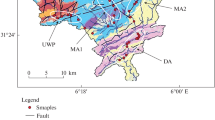Abstract
Clay minerals in 32 samples collected from the upper 6 meters of drill core LF 82/1-3 in Lake Frome, Australia have been examined using X-ray powder diffraction techniques. The results show that the clay mineral species are predominated by illite, kaolinite and a small amount of montmorillonite. Minor chlorite and vermiculite can also be identified in some of the samples. In terms of clay mineral species, crystallinity and other characteristics, the upper 6-m core can be divided into 3 sections, the boundaries of which are marked at depths of about 125–150 cm and 415–455 cm with ages of 14 and 19 thousand years B.P., respectively. The middle section at a burial depth of 150–415 cm may have been deposited under moist conditions while the other two under relatively dry conditions. Additionally, some slight climatic fluctuations seem possible in different stages.
Similar content being viewed by others
References
Bowler, J.M.,et al., Quaternary Research, 6(1976), 359–394.
Galloway, R.W.,Journal of Geology, 73(1965), 603–618.
Hope, G.S.et al., Bulletin of Royal Society of New Zealand, 13(1975), 155–162.
Author information
Authors and Affiliations
Rights and permissions
About this article
Cite this article
Honghan, Z., Bowler, J.M. Clay minerals in Lake Frome sediments of Australia and their paleoclimatic implications. Chin. J. of Geochem. 5, 241–249 (1986). https://doi.org/10.1007/BF02864876
Issue Date:
DOI: https://doi.org/10.1007/BF02864876




